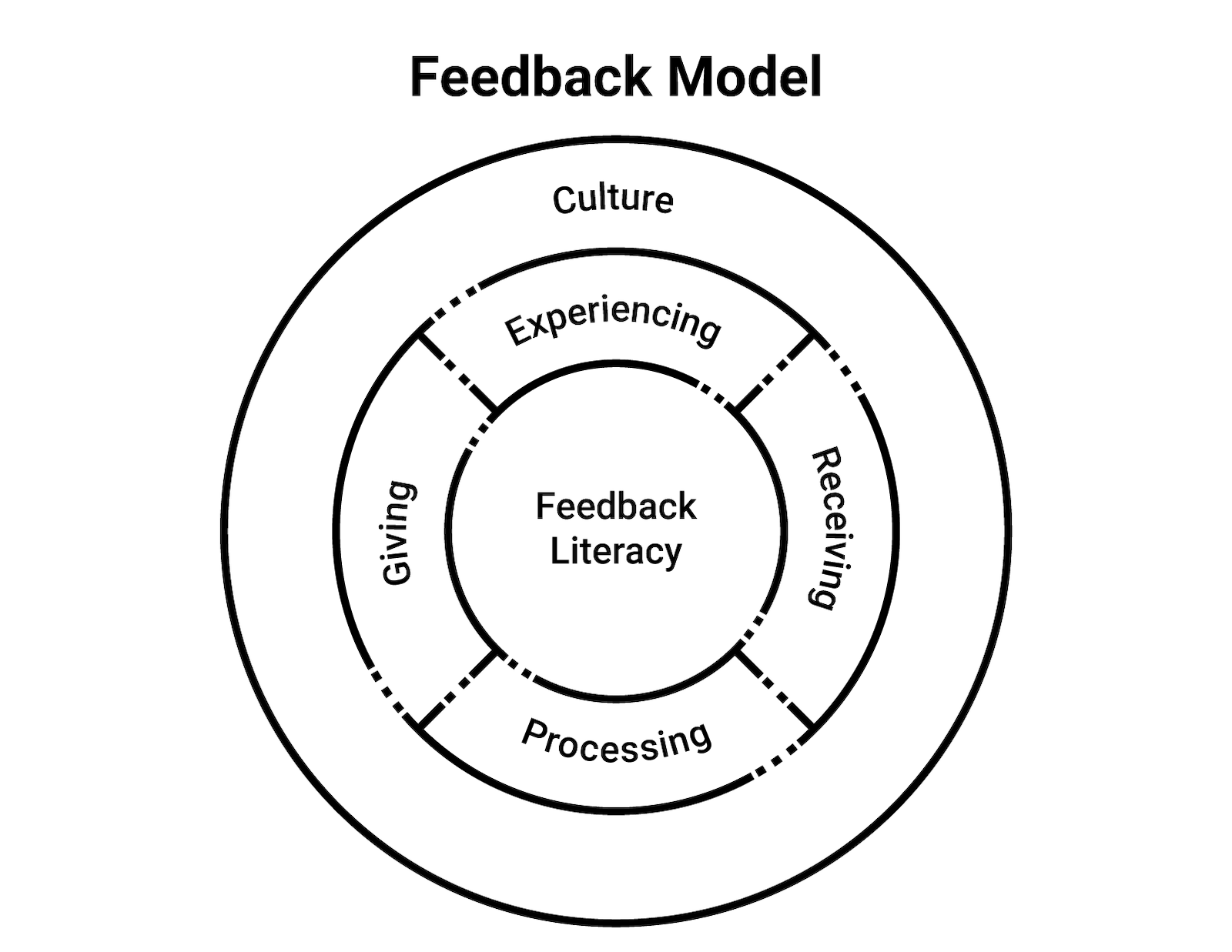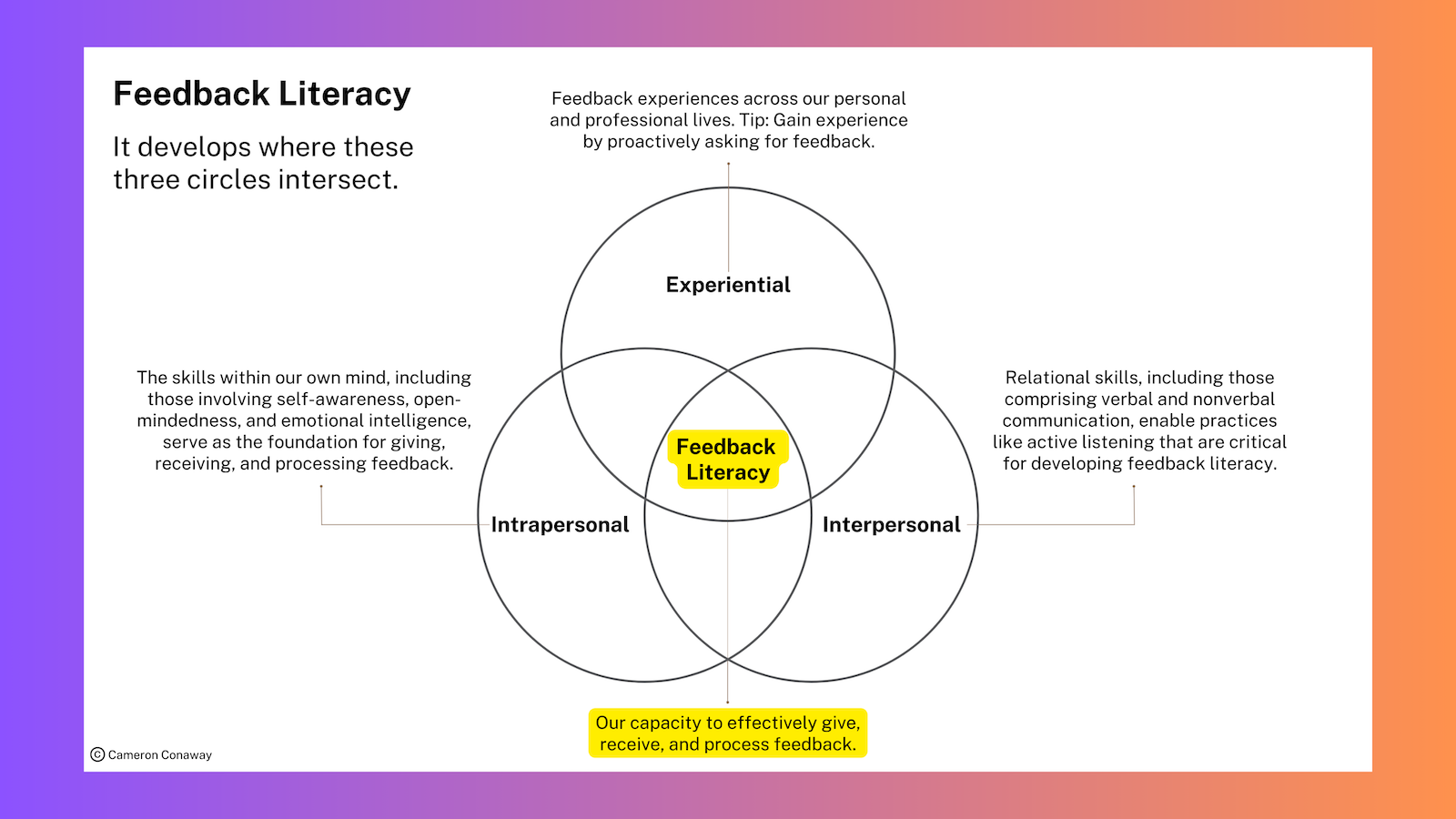
Building an effective feedback culture is not just about organizational growth, but also about empowering individuals to reach their full potential. This post will delve into the five essential parts necessary for cultivating a feedback culture, highlighting the interconnectedness of feedback literacy, individual skills, and organizational systems. Let’s explore the key components and actionable strategies for fostering a culture where feedback is not just valued, but also a catalyst for personal and professional growth.
Part 1: Feedback Relationship Model & Feedback Culture

Overview of the Model
The feedback relationship model is not just a theoretical concept-it’s a practical tool that can help you and your team understand how various feedback dimensions are interconnected. To build an effective feedback culture means ensuring everyone is on the same page about what feedback is and how it works.
At its core is feedback literacy, surrounded by specific feedback skills like giving, receiving, processing, and experiencing feedback. This model provides a comprehensive framework that you can use to understand and improve your organizational feedback dynamics.
Feedback Literacy at the Core
Feedback literacy is the ability to effectively give, receive, ask for, process, and use feedback. It is an individual capacity that can be developed and enhanced through practice and experience.
Specific Feedback Skills
- Giving Feedback: Offering constructive and actionable insights.
- Receiving Feedback: Being open and receptive feedback.
- Processing Feedback: Reflecting on and metabolizing feedback to understand it.
- Experiencing Feedback: Engaging in feedback interactions to build literacy.
What is a Feedback Culture?
A feedback culture is an environment where feedback is continuously exchanged and valued. In such an environment, team members are encouraged to give, receive, seek, process, and use feedback. This environment supports the ongoing development of feedback literacy among all team members, contributing to a culture of learning and improvement, which is vital for organizations to stay resilient in competitive environments. The foundation of such a culture is team psychological safety, where all members feel safe enough to give feedback. However, it should be noted that while a department may be psychologically unsafe, a particular team within that department may have a strong sense of psychological safety.
As you can see from the porous nature of the model, all parts flow into each other. So while the overall feedback culture may influence how folks give, receive, process, and experience, those particular elements also flow out and impact the culture. In the healthiest feedback cultures I’ve seen, employees are:
- taught how to give, receive, seek, and process feedback
- given space to process feedback, particularly challenging feedback
- have opportunities to practice and experience the various dimensions of feedback
- are able to see these dimensions modeled for them, usually by senior leaders
Part 2: Feedback Literacy Overview

Exploring Feedback Literacy
Feedback literacy encompasses the skills and knowledge needed to engage in feedback processes effectively. It involves understanding the multidimensional nature of feedback and its role in professional development. It’s important to note that feedback literacy isn’t something we only build at work. Feedback events occur regularly in our daily lives, often without us realizing it. In her book, Feedback Fundamentals and Evidence-Based Practices, Dr. Brodie Gregory Riordan refers to these moments as “feedback events,” highlighting how they include not only formal performance reviews but also all the subtle feedback moments of our daily lives (like our hand conveying to us the pain of touching that hot stove).
Three Primary Areas of Feedback Literacy
Building these capacities of feedback literacy as individuals play a large role in impacting the overall feedback culture. Even to this day, I’m often surprised at how a very feedback-literate leader, in consistently modeling these skills, can dramatically improve a team’s culture. As noted in the diagram, the primary areas are:
- Intrapersonal: Internal skills like self-awareness and emotional intelligence.
- Interpersonal: Relational skills like communication and active listening.
- Experiential: Practical experiences and interactions that build feedback skills.
Part 3: Developing Feedback Literacy
While feedback literacy can be built at the individual level, it also takes being in relationship with others. Here is an exploration of the parts:
Intrapersonal Development
- Self-Awareness: Practices like mindfulness, journaling, and working with therapists or coaches can enhance self-awareness and emotional intelligence.
- Emotional Intelligence: Recognizing and managing emotions to stay receptive during feedback conversations.
Interpersonal Development
- Setting Intentions and Goals: Practicing active listening and clear communication. Set intentions for each interaction and longer-term goals for personal growth.
- Asking for Feedback: Regularly seeking feedback from colleagues, managers, and mentors.
- Studying Recordings: Reviewing one’s recordings to identify areas for improvement.
- Lifelong Learning: Continuously engaging with helpful resources. Two books you may find helpful: Nonviolent Communication and Mindful Communication.
Note: for more on how to build feedback literacy at the team level, read: Building Team Feedback Literacy
Experiential Development
- Post-Feedback Reflection: Journaling about feedback experiences to gain insights.
- 24-Hour Feedback Inventory: Recording daily feedback events to increase awareness.
- Request Training: Participating in or organizing feedback training sessions.
- Stretch Assignments: Taking on projects that provide opportunities for feedback and growth.
Part 4: Feedback Culture Exploration
Understanding Feedback Culture
As stated, a healthy feedback culture significantly impacts organizational learning and development. It involves creating an environment where feedback is regularly exchanged and valued.
Three-Step Process for Feedback Culture Conversations
- Discuss Feedback: Bring the team together to discuss what feedback is and co-create a feedback definition.
- Introduce Feedback Literacy: Use frameworks and graphics to explain feedback literacy.
- Co-Create Development Plans: Work with each team member to develop individualized feedback literacy plans.
Key Questions for Leaders
- Are employees receiving the feedback they want and need?: Ensure feedback meets employee expectations. Remember: many employees literally leave companies because they are not getting the feedback they need.
- Are we training employees to seek feedback, including from external sources?: Like all other parts, this is a skill that must be developed.
- What feedback training are we providing to new managers?: Equip new managers with necessary feedback skills. These new managers are often hungry to understand how to build an effective feedback culture, but very few have had trained or had effective feedback conversations modeled for them.
Feedback Culture as Soil
Think of feedback culture as the soil where effective feedback is cultivated. Neglecting this culture can lead to a feedback-averse environment, while intentional cultivation fosters a healthy feedback ecosystem.
Part 5: Feedback Systems at the Organizational Level

At the organizational level, a feedback culture is only as healthy as its feedback systems.
Introduction to the 3Cs of Organizational Feedback Systems
- Collect: Gather feedback from various sources.
- Classify: Aggregate and organize feedback in a central location.
- Communicate: Route feedback to relevant stakeholders.
Feedback Collection

Map out all feedback sources and create a process for monitoring them. For example, you can collect customer feedback from both internal and public sources.
Feedback Classification
Organize feedback to make it actionable. Classify feedback by type, source, and relevance. In many cases, organizations are capturing a ton of feedback, but they limit the cultural aspect because they aren’t classifying it (and then communicating it) effectively. Remember: collecting all the feedback is the same as collecting a big pile of data; it doesn’t matter until you make it matter.
Feedback Communication
Ensure feedback reaches the appropriate people or teams. Create feedback lakes from the feedback river to distribute insights effectively.
Conclusion
Building an effective feedback culture is a continuous process that requires commitment from all levels of the organization, especially from leaders who play a crucial role in setting the tone. By focusing on feedback literacy, developing individual and team skills, and implementing strategic feedback systems, leaders can create a culture where feedback is valued and effectively utilized for growth at all levels. Start implementing these strategies today to foster a feedback-friendly environment and demonstrate your commitment to continuous improvement.